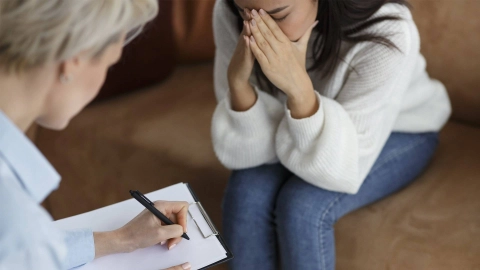Conditions Generalized anxiety disorder
ICD codes: F41.1 What are ICD codes?
Fear has an important protective function in the case of danger: it puts people in a state of readiness so that they can react quickly. However, in the case of generalized anxiety disorder, everyday life is consumed by excessive worry. This article explains how it is diagnosed and treated.
At a glance
- It is normal to sometimes feel scared or anxious.
- When faced with danger, for example while driving, fear has an important protective function – it puts the body in a state of readiness so that it can react quickly.
- However, some people experience constant worry about each and every aspect of their lives.
- Generalized anxiety disorder can be expressed both emotionally and physically.
- Although the disorder can be difficult to overcome, various treatment options are available.
Note: The information in this article cannot and should not replace a medical consultation and must not be used for self-diagnosis or treatment.

What is generalized anxiety disorder?
It is normal to sometimes feel anxious or to experience real fear. In the case of danger, fear has an important protective function – fear puts people in a state of readiness so that they can react quickly, for example in critical situations while driving. Worry and fears can also have a protective function in the case of work and family. For example, fear allows people to be more careful and helps them to avoid difficult situations.
However, when worry and fear take control, they can become a source of stress. People of any age can suddenly find that their lives are entirely consumed by fear and anxiety. They experience constant worry and irrational fears, and the anxiety will not go away. These symptoms may indicate a generalized anxiety disorder (GAD).
Even though people with an anxiety disorder typically know that their fears are excessive, they are unable to control them and find it difficult to deal with this situation alone. However, various treatment options are available.
What are the signs of generalized anxiety disorder?
Generalized anxiety disorder can be expressed both emotionally and physically. The mental symptoms include persistent, irrational, and exaggerated fears. Those affected are not just afraid of specific threats or situations.
Their anxiety relates to a wide range of areas of their life. As the anxiety may be experienced in relation to anything at all and does not have any specific triggers, experts refer to it as “generalized anxiety”.
For example, a person with a generalized anxiety disorder may suddenly start to worry that their child could be involved in a car accident on the way to school. This thought immediately leads to anxiety about their partner getting into an accident on the way to work. Which in turn causes them to worry that they themselves could have a heart attack.
People with this type of anxiety disorder can experience worry about practically anything. These persistent fears greatly impact daily life or even make normal life impossible. They can also lower mood and lead to depression.
Additional possible symptoms include:
- dazed feeling
- nervousness
- dizziness
- trembling
- sweating
- muscle tension
- heart palpitations
- gastric distress
Being in a constant state of anxiety can cause fatigue, difficulty concentrating, and insomnia. The risk of suicide may increase, especially if depression is experienced alongside the anxiety.
If a person experiences fear in certain situations only, this is unlikely to be due to a generalized anxiety disorder. Although sudden-onset anxiety and panic attacks are not characteristic of generalized anxiety disorder, they can sometimes also be additional symptoms.
Important: The adrenal glands secrete the hormone adrenaline under conditions of fear. As a result, numerous body functions are accelerated. Typically, alertness and responsiveness are temporarily increased. In people with generalized anxiety disorder, this physical state of alarm may be constant.

What are the causes of generalized anxiety disorder?
The cause of generalized anxiety disorder is not yet fully understood. Both biological and psychological factors are likely to play a role.
Some people with a generalized anxiety disorder have experienced a major traumatic event during childhood or later in life or have suffered a major loss. In addition, many highly stressful experiences, such as significant family stress or persistently extreme workloads can also be factors.
Life crises can also trigger anxiety that can develop into generalized anxiety disorder. There may be a hereditary component that can make certain people more susceptible to the disorder.
Generalized anxiety disorder is sometimes the result of another condition – for example, depression or a panic disorder. Generalized anxiety disorders can be associated with addictive disorders. However, they can also occur without an identifiable cause.
How common is generalized anxiety disorder?
Generalized anxiety disorder typically develops slowly and is often initially not noticeable. A pronounced anxiety disorder can often last months or years. Until they manage to overcome it, those affected often experience both good and bad phases. Most anxiety disorders begin in adults of middle age.
Over the long term, the percentage of people who overcome their anxiety is high. According to one study, approximately one quarter of those taking part were able to overcome their anxiety disorder after two years.
How is generalized anxiety disorder diagnosed?
Since there are many types of anxiety disorders with different symptoms, exact diagnosis can be difficult. Anxiety disorders include phobias, panic disorders, and obsessive-compulsive disorders. Many people with an anxiety disorder also have signs of depression.
Therefore, generalized anxiety disorder can only be diagnosed after a thorough consultation with a trained professional. This can be a psychologist or a psychiatrist.
To select a suitable treatment, it is important to determine the main symptoms and problems.
Generalized anxiety disorder is diagnosed when excessive fears:
- are present most days
- persist for at least six months
- are uncontrollable
- are so stressful that they affect daily life
In addition, there must be at least three physical symptoms of anxiety, e.g. increased pulse, trembling, muscle tension, or gastric distress.
Important: The physical symptoms listed here can also be caused by other conditions, including hyperthyroidism. Such symptoms can also be triggered by certain medications or drugs like amphetamines (speed). Therefore, doctors also ask about other possible explanations for symptoms.
It can take a while to definitively diagnose generalized anxiety disorder. Often, people with a generalized anxiety disorder initially consult a doctor because of physical symptoms. As a result, only one symptom of the disorder may be treated in some cases, e.g. sleep disturbances.
How is generalized anxiety disorder treated?
There are various ways to get an anxiety disorder under control over time. People can find ways to deal more effectively with anxiety and stress. Medication represents another option for alleviating symptoms. However, a generalized anxiety disorder is not something that can be overcome quickly and easily.
There are four different approaches to treatment:
- Psychological and psychotherapeutic treatments: these include, for example, cognitive behavioral therapy, which helps people learn to control or change their thinking patterns and their fears.
- Relaxation techniques: these include autogenic training and progressive muscle relaxation. These techniques can contribute to better relaxation and stress management. They are often also offered as part of psychotherapeutic treatment.
- Medication: certain antidepressants are primarily considered for generalized anxiety disorder. Some people also use a natural relaxant, like valerian.
- Self-help: people can share their personal experience with others in self-help groups. Some people find it helpful to be well informed about the disorder and read books, brochures, or information on the Internet.
For more detailed information, for example about treatment options for generalized anxiety disorder, see gesundheitsinformation.de.
- Bandelow B, Boerner RJ, Kasper S et al. Generalisierte Angststörung. Diagnostik und Therapie. Dtsch Arztebl Int 2013; 110(17): 300-310. doi: 10.3238/arztebl.2013.0300.
- Deutsche Gesellschaft für Psychosomatische Medizin und Ärztliche Psychotherapie e.V. (DGPM). Behandlung von Angststörungen. S3-Leitlinie. AWMF-Registernummer 051-028. Version 2. 04.2021.
- Gale CK, Millichamp J. Generalised anxiety disorder. BMJ Clin Evid. 2011 Oct 27;2011:1002. PMID: 22030083; PMCID: PMC3275153.
- Hieu TH, Dibas M, Surya Dila KA et al. Therapeutic efficacy and safety of chamomile for state anxiety, generalized anxiety disorder, insomnia, and sleep quality: A systematic review and meta-analysis of randomized trials and quasi-randomized trials. Phytother Res. 2019 Jun;33(6):1604-1615. doi: 10.1002/ptr.6349. Epub 2019 Apr 21. PMID: 31006899.
- Hoge EA, Ivkovic A, Fricchione GL. Generalized anxiety disorder: diagnosis and treatment. BMJ. 2012 Nov 27;345:e7500. doi: 10.1136/bmj.e7500. PMID: 23187094.
- Hurtado MM, Villena A, Vega A et al. ‘I have anxiety, but I have values and preferences’: Experiences of users with generalized anxiety disorder: A qualitative study. Int J Ment Health Nurs. 020 Jun;29(3):521-530. doi: 10.1111/inm.12690. Epub 2020 Jan 7. PMID: 31908140.
- National Institute for Health and Care Excellence (NICE). Generalised anxiety disorder and panic disorder in adults: management. NICE Clinical guidelines; Band CG113. 07.2019.
In cooperation with the Institute for Quality and Efficiency in Health Care (Institut für Qualität und Wirtschaftlichkeit im Gesundheitswesen – IQWiG).
As at:






